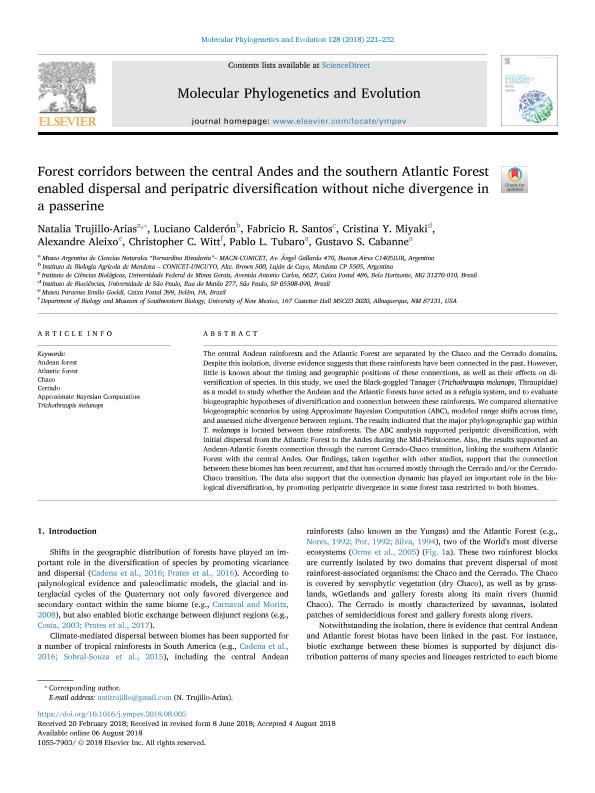Mostrar el registro sencillo del ítem
dc.contributor.author
Trujillo Arias, Natalia

dc.contributor.author
Calderón, Pablo Luciano Sebastian

dc.contributor.author
Santos, Fabricio R.

dc.contributor.author
Miyaki, Cristina Yumi

dc.contributor.author
Aleixo, Alexandre
dc.contributor.author
Witt, Christopher C.
dc.contributor.author
Tubaro, Pablo Luis

dc.contributor.author
Cabanne, Gustavo Sebastián

dc.date.available
2019-12-17T22:14:13Z
dc.date.issued
2018-11
dc.identifier.citation
Trujillo Arias, Natalia; Calderón, Pablo Luciano Sebastian; Santos, Fabricio R.; Miyaki, Cristina Yumi; Aleixo, Alexandre; et al.; Forest corridors between the central Andes and the southern Atlantic Forest enabled dispersal and peripatric diversification without niche divergence in a passerine; Academic Press Inc Elsevier Science; Molecular Phylogenetics and Evolution; 128; 11-2018; 221-232
dc.identifier.issn
1055-7903
dc.identifier.uri
http://hdl.handle.net/11336/92449
dc.description.abstract
The central Andean rainforests and the Atlantic Forest are separated by the Chaco and the Cerrado domains. Despite this isolation, diverse evidence suggests that these rainforests have been connected in the past. However, little is known about the timing and geographic positions of these connections, as well as their effects on diversification of species. In this study, we used the Black-goggled Tanager (Trichothraupis melanops, Thraupidae) as a model to study whether the Andean and the Atlantic forests have acted as a refugia system, and to evaluate biogeographic hypotheses of diversification and connection between these rainforests. We compared alternative biogeographic scenarios by using Approximate Bayesian Computation (ABC), modeled range shifts across time, and assessed niche divergence between regions. The results indicated that the major phylogeographic gap within T. melanops is located between these rainforests. The ABC analysis supported peripatric diversification, with initial dispersal from the Atlantic Forest to the Andes during the Mid-Pleistocene. Also, the results supported an Andean-Atlantic forests connection through the current Cerrado-Chaco transition, linking the southern Atlantic Forest with the central Andes. Our findings, taken together with other studies, support that the connection between these biomes has been recurrent, and that has occurred mostly through the Cerrado and/or the Cerrado-Chaco transition. The data also support that the connection dynamic has played an important role in the biological diversification, by promoting peripatric divergence in some forest taxa restricted to both biomes.
dc.format
application/pdf
dc.language.iso
eng
dc.publisher
Academic Press Inc Elsevier Science

dc.rights
info:eu-repo/semantics/openAccess
dc.rights.uri
https://creativecommons.org/licenses/by-nc-sa/2.5/ar/
dc.subject
ANDEAN FOREST
dc.subject
APPROXIMATE BAYESIAN COMPUTATION
dc.subject
ATLANTIC FOREST
dc.subject
CERRADO
dc.subject
CHACO
dc.subject
TRICHOTHRAUPIS MELANOPS
dc.subject.classification
Zoología, Ornitología, Entomología, Etología

dc.subject.classification
Ciencias Biológicas

dc.subject.classification
CIENCIAS NATURALES Y EXACTAS

dc.title
Forest corridors between the central Andes and the southern Atlantic Forest enabled dispersal and peripatric diversification without niche divergence in a passerine
dc.type
info:eu-repo/semantics/article
dc.type
info:ar-repo/semantics/artículo
dc.type
info:eu-repo/semantics/publishedVersion
dc.date.updated
2019-10-15T14:12:09Z
dc.journal.volume
128
dc.journal.pagination
221-232
dc.journal.pais
Países Bajos

dc.journal.ciudad
Amsterdam
dc.description.fil
Fil: Trujillo Arias, Natalia. Consejo Nacional de Investigaciones Científicas y Técnicas. Oficina de Coordinación Administrativa Parque Centenario. Museo Argentino de Ciencias Naturales “Bernardino Rivadavia”; Argentina
dc.description.fil
Fil: Calderón, Pablo Luciano Sebastian. Consejo Nacional de Investigaciones Científicas y Técnicas. Centro Científico Tecnológico Conicet - Mendoza. Instituto de Biología Agrícola de Mendoza. Universidad Nacional de Cuyo. Facultad de Ciencias Agrarias. Instituto de Biología Agrícola de Mendoza; Argentina
dc.description.fil
Fil: Santos, Fabricio R.. Universidade Federal de Minas Gerais; Brasil
dc.description.fil
Fil: Miyaki, Cristina Yumi. Universidade de Sao Paulo; Brasil
dc.description.fil
Fil: Aleixo, Alexandre. Museu Paraense Emilio Goeldi; Brasil
dc.description.fil
Fil: Witt, Christopher C.. University of New Mexico; Estados Unidos
dc.description.fil
Fil: Tubaro, Pablo Luis. Consejo Nacional de Investigaciones Científicas y Técnicas. Oficina de Coordinación Administrativa Parque Centenario. Museo Argentino de Ciencias Naturales “Bernardino Rivadavia”; Argentina
dc.description.fil
Fil: Cabanne, Gustavo Sebastián. Consejo Nacional de Investigaciones Científicas y Técnicas. Oficina de Coordinación Administrativa Parque Centenario. Museo Argentino de Ciencias Naturales “Bernardino Rivadavia”; Argentina
dc.journal.title
Molecular Phylogenetics and Evolution

dc.relation.alternativeid
info:eu-repo/semantics/altIdentifier/url/https://linkinghub.elsevier.com/retrieve/pii/S105579031830109X
dc.relation.alternativeid
info:eu-repo/semantics/altIdentifier/doi/https://doi.org/10.1016/j.ympev.2018.08.005
Archivos asociados
